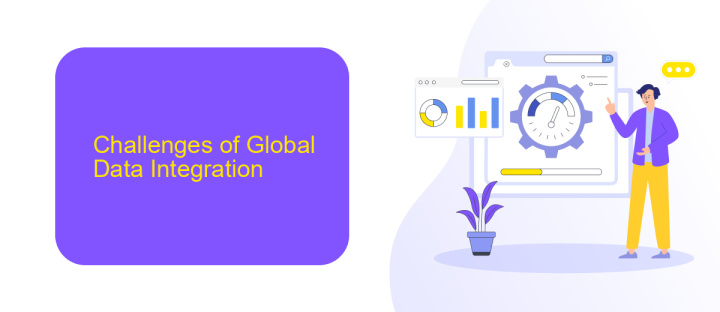Global Data Integration
In an increasingly interconnected world, the ability to seamlessly integrate data from diverse global sources is paramount. Global Data Integration enables organizations to harness the power of vast datasets, driving informed decision-making and fostering innovation. This article explores the challenges, strategies, and technologies essential for effective global data integration, ensuring businesses stay competitive in a data-driven era.
Introduction
Global Data Integration is a critical aspect of modern business operations, enabling organizations to seamlessly connect disparate data sources and streamline workflows. As companies expand and diversify, the need for efficient data integration becomes paramount to maintain data consistency and accessibility. This process involves the consolidation of data from various platforms, ensuring that information is accurate, up-to-date, and easily accessible for decision-making.
- Enhances data accuracy and reliability
- Improves operational efficiency
- Facilitates real-time data access
- Supports better decision-making
One of the leading solutions in this domain is ApiX-Drive, a powerful tool that simplifies the integration process. ApiX-Drive allows businesses to connect multiple applications and automate data transfer without requiring extensive technical expertise. By leveraging such tools, organizations can ensure seamless data flow, reduce manual workload, and enhance overall productivity. In an era where data drives business success, effective global data integration is indispensable.
Challenges of Global Data Integration

Global data integration presents numerous challenges, primarily due to the diverse and complex nature of data sources across different regions. One of the most significant hurdles is ensuring data consistency and accuracy when merging datasets from various systems, which often have incompatible formats and standards. Additionally, varying data privacy regulations and compliance requirements across countries add another layer of complexity, necessitating sophisticated data governance strategies to ensure legal and ethical data usage.
Another challenge is the technical aspect of integrating disparate systems, which often requires substantial time and resources. This is where services like ApiX-Drive come into play, offering automated solutions to streamline the integration process. ApiX-Drive facilitates the connection between different software applications, enabling seamless data flow without the need for extensive manual intervention. By leveraging such tools, organizations can overcome technical barriers and focus on deriving actionable insights from their integrated data.
Benefits of Global Data Integration

Global data integration offers numerous advantages for businesses looking to streamline their operations and improve decision-making processes. By integrating data from multiple sources, organizations can achieve a unified view of their data, leading to more accurate and timely insights.
- Enhanced Decision-Making: With integrated data, businesses can make more informed decisions based on comprehensive and up-to-date information.
- Increased Efficiency: Automating data integration reduces the need for manual data entry, saving time and reducing errors.
- Improved Collaboration: Teams across different departments can access the same data, fostering better communication and collaboration.
- Cost Savings: Streamlined data processes can lead to significant cost reductions by eliminating redundant data storage and minimizing IT overhead.
Services like ApiX-Drive facilitate seamless global data integration by providing tools to connect various data sources effortlessly. This not only simplifies the integration process but also ensures that businesses can quickly adapt to changing data needs without extensive technical expertise. As a result, companies can focus more on strategic initiatives rather than getting bogged down by data management challenges.
Best Practices for Global Data Integration

Effective global data integration is crucial for businesses aiming to leverage data from diverse sources across the world. Ensuring seamless integration requires careful planning and adherence to best practices. One of the key aspects is to prioritize data quality and consistency, which can be achieved through standardized data formats and validation processes.
Another essential practice is to implement robust security measures to protect sensitive information during data transfer. This includes encryption, secure access controls, and regular security audits. Additionally, leveraging cloud-based integration platforms like ApiX-Drive can simplify the process by offering automated workflows and real-time data synchronization.
- Standardize data formats and validation processes
- Implement robust security measures
- Utilize cloud-based integration platforms such as ApiX-Drive
- Regularly monitor and audit data integration processes
By following these best practices, organizations can ensure that their global data integration efforts are efficient, secure, and scalable. This not only enhances data-driven decision-making but also provides a competitive edge in today’s data-centric business environment.


Conclusion
Global data integration is essential for modern businesses aiming to leverage diverse data sources for informed decision-making. By seamlessly connecting disparate systems, organizations can achieve a unified view of their data, enhancing operational efficiency and strategic insights. The process of integrating data globally involves overcoming challenges related to data quality, security, and interoperability. However, the benefits far outweigh these challenges, offering a competitive edge in a data-driven world.
Tools and services like ApiX-Drive play a crucial role in simplifying the integration process. ApiX-Drive provides a user-friendly platform that enables businesses to connect various applications and automate data workflows without the need for extensive technical expertise. By utilizing such services, companies can streamline their data integration efforts, ensuring that accurate and timely information is readily available across all departments. In conclusion, embracing global data integration and leveraging advanced tools can significantly enhance an organization's ability to adapt and thrive in an increasingly complex digital landscape.
FAQ
What is Global Data Integration?
Why is Global Data Integration important for businesses?
What challenges are commonly faced in Global Data Integration?
How can businesses automate their data integration processes?
What are the key features to look for in a data integration tool?
Routine tasks take a lot of time from employees? Do they burn out, do not have enough working day for the main duties and important things? Do you understand that the only way out of this situation in modern realities is automation? Try Apix-Drive for free and make sure that the online connector in 5 minutes of setting up integration will remove a significant part of the routine from your life and free up time for you and your employees.

